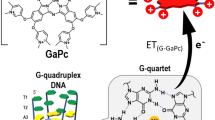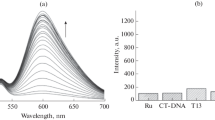Abstract
Singlet oxygen quantum yields (Φ Δ) of different perylene diimides (PDIs) containing phenyl (PDI-Ph), pyrene (PDI-Pyr), and indole (PDI-In) units in bay positions of the ring were determined using 1,3-diphenylisobenzofuran (DPBF) method in toluene/methanol (99:1) system. Pyrene-substituted PDI were the most efficient singlet oxygen generator among the investigated photosensitizers with a quantum yield of Φ Δ = 0.93 in toluene/methanol. Additionally, their binding affinities to G-quadruplex DNA structure were investigated by steady-state measurements. There were marked red shifts of absorbance bands for PDI-Pyr/DNA strand complexes with respect to the absorption maxima of DNA-free solution of PDI-Pyr in phosphate buffer at pH 6.







Similar content being viewed by others
References
Korbelik M, Naraparaju VR, Yamamato N (1997) Macrophage-directed immunotherapy as adjuvant to photodynamic therapy of cancer. Br J Cancer 75:202–207
Copper MP, Triesscheijn M, Tan IB, Ruevekamp MC, Stewart FA (2007) Photodynamic therapy in the treatment of multiple primary tumours in the head and neck, located to the oral cavity and oropharynx. Clin Otolaryngol 32:185–189
Phillips D (2010) Light relief: photochemistry and medicine. Photochem Photobiol Sci 9:1589–1596
Ikeda N, Usuda J, Kato H, Ishizumi T, Ichinose S, Otani K, Honda H, Furukawa K, Okunaka T, Tsutsui H (2011) New aspects of photodynamic therapy for central type early stage lung cancer. Laser Surg Med 43:749–754
Niemz MH (2007) Laser-tissue interactions fundamentals and applications. Springer, New York, pp 49–56
La Penna M, Alvarez MG, Yslas EI, Rivarola V, Durantini EN (2001) Photodynamic activity of 5,10,15,20-tetrakis (4-methoxyphenyl)porphyrin on the Hep-2 human carcinoma cell line: effect of light dose and wavelength range. Bioorg Chem 29:130–139
Milanesio ME, Alvarez MG, Silber JJ, Rivarola V, Durantini EN (2003) Photodynamic activity of monocationic and non-charged methoxyphenylporphyrin derivatives in homogeneous and biological media. Photochem Photobiol Sci 2:926–933
Schmidt R, Tanielian C (2000) Time-resolved determination of the quantum yield of singlet oxygen formation by tetraphenylporphine under conditions of very strong quenching. J Phys Chem A 104:3177–3180
Yukruk F, Dogan AL, Canpinar H, Guc D, Akkaya EU (2005) Water-soluble green perylenediimide (PDI) dyes as potential sensitizers for photodynamic therapy. Org Lett 7:2885–2887
Jin YH, Hua JL, Wu WJ, Ma XM, Meng FS (2008) Synthesis, characterization and photovoltaic properties of two novel near-infrared absorbing perylene dyes containing benzo[e]indole for dye-sensitized solar cells. Synth Met 158:64–71
Zafer C, Kus M, Turkmen G, Dincalp H, Demic S, Kuban B, Teoman Y, Icli S (2007) New perylene derivative dyes for dye-sensitized solar cells. Sol Energy Mater Sol Cells 91:427–431
Chiu TL, Chuang KH, Lin CF, Ho YH, Lee JH, Chao CC, Leung MK, Wan DH, Li CY, Chen HL (2009) Low reflection and photo-sensitive organic light-emitting device with perylene diimide and double-metal structure. Thin Solid Films 517:3712–3716
Kim SH, Yang YS, Lee JH, Lee JI, Chu HY, Lee H, Oh J, Do LM, Zyung T (2003) Organic field-effect transistors using perylene. Opt Mater 21:439–443
Hayes RT, Wasielewski MR, Gosztola D (2000) Ultrafast photoswitched charge transmission through the bridge molecule in a donor-bridge-acceptor system. J Am Chem Soc 122:5563–5567
Langhals H, Karolin J, Johansson LBA (1998) Spectroscopic properties of new and convenient standards for measuring fluorescence quantum yields. J Chem Soc Faraday Trans 94:2919–2922
Chao CC, Leung MK, Su YO, Chiu KY, Lin TH, Shieh SJ, Lin SC (2005) Photophysical and electrochemical properties of 1,7-diaryl-substituted perylene diimides. J Org Chem 70:4323–4331
Zhao Q, Zhang HY (2005) Singlet-oxygen-generating activity of deuterated perylenequinonoid pigments. Dyes Pigments 66:15–17
Icli S, Demic S, Dindar B, Doroshenko AO, Timur C (2000) Photophysical and photochemical properties of a water-soluble perylene diimide derivative. J Photochem Photobiol A Chem 136:15–24
Dincalp H, Icli S (2006) Photoinduced electron transfer-catalyzed processes of sulfoamino perylene diimide under concentrated sun light. Sol Energy 80:332–346
Karapire C, Zafer C, Icli S (2004) Studies on photophysical and electrochemical properties of synthesized hydroxy perylenediimides in nanostructured titania thin films. Synth Met 145:51–60
Kerwin SM, Chen G, Kern JT, Thomas PW (2002) Perylene diimide G-quadruplex DNA binding selectivity is mediated by ligand aggregation. Bioorg Med Chem Lett 12:447–450
Kern JT, Thomas PW, Kerwin SM (2002) The relationship between ligand aggregation and G-quadruplex DNA selectivity in a series of 3,4,9,10-perylenetetracarboxylic acid diimides. Biochemistry 41:11379–11389
Fedoroff OY, Salazar M, Han HY, Chemeris VV, Kerwin SM, Hurley LH (1998) NMR-based model of a telomerase-inhibiting compound bound to G-quadruplex DNA. Biochemistry 37:12367–12374
Dai JX, Carver M, Yang DZ (2008) Polymorphism of human telomeric quadruplex structures. Biochimie 90:1172–1183
Nakamura TM, Morin GB, Chapman KB, Weinrich SL, Andrews WH, Lingner J, Harley CB, Cech TR (1997) Telomerase catalytic subunit homologs from fission yeast and human. Science 277:955–959
Haider SM, Neidle S, Parkinson GN (2011) A structural analysis of G-quadruplex/ligand interactions. Biochimie 93:1239–1251
Neidle S (2010) Human telomeric G-quadruplex: the current status of telomeric G-quadruplexes as therapeutic targets in human cancer. FEBS J 277:1118–1125
Bugaj AM (2011) Targeted photodynamic therapy - a promising strategy of tumor treatment. Photochem Photobiol Sci 10:1097–1109
Shieh YA, Yang SJ, Wei MF, Shieh MJ (2010) Aptamer-based tumor-targeted drug delivery for photodynamic therapy. ACS Nano 4:1433–1442
Abdel-Shafi AA, Worrall DR, Wilkinson F (2001) Singlet oxygen formation efficiencies following quenching of excited singlet and triplet states of aromatic hydrocarbons by molecular oxygen. J Photochem Photobiol A Chem 142:133–143
Criado S, Martire D, Allegretti P, Furlong J, Bertolotti SG, La Falce E, Garcia N (2002) Singlet molecular oxygen generation and quenching by the antiglaucoma ophthalmic drugs, Timolol and Pindolol. Photochem Photobiol Sci 1:788–792
Dincalp H, Kizilok S, Icli S (2010) Fluorescent macromolecular perylene diimides containing pyrene or indole units in bay positions. Dyes Pigments 86:32–41
Wetzler DE, Garcia-Fresnadillo D, Orellana G (2006) A clean, well-defined solid system for photosensitized O-1(2) production measurements. Phys Chem Chem Phys 8:2249–2256
Han HY, Cliff CL, Hurley LH (1999) Accelerated assembly of G-quadruplex structures by a small molecule. Biochemistry 38:6981–6986
Anantha NV, Azam M, Sheardy RD (1998) Porphyrin binding to quadruplexed T(4)G(4). Biochemistry 37:2709–2714
Wei CY, Jia GQ, Zhou J, Han GY, Li C (2009) Evidence for the binding mode of porphyrins to G-quadruplex DNA. Phys Chem Chem Phys 11:4025–4032
Kern JT, Kerwin SM (2002) The aggregation and G-quadruplex DNA selectivity of charged 3,4,9,10-perylenetetracarboxylic acid diimides. Bioorg Med Chem Lett 12:3395–3398
Rossetti L, Franceschin M, Schirripa S, Bianco A, Ortaggi G, Savino M (2005) Selective interactions of perylene derivatives having different side chains with inter- and intramolecular G-quadruplex DNA structures. A correlation with telomerase inhibition. Bioorg Med Chem Lett 15:413–420
Samudrala R, Zhang X, Wadkins RM, Mattern DL (2007) Synthesis of a non-cationic, water-soluble perylenetetracarboxylic diimide and its interactions with G-quadruplex-forming DNA. Bioorg Med Chem 15:186–193
Lindegaard D, Madsen AS, Astakhova IV, Malakhov AD, Babu BR, Korshun VA, Wengel J (2008) Pyrene-perylene as a FRET pair coupled to the N2′-functionality of 2′-amino-LNA. Bioorg Med Chem 16:94–99
Wanninger-Weiss C, Valis L, Wagenknecht HA (2008) Pyrene-modified guanosine as fluorescent probe for DNA modulated by charge transfer. Bioorg Med Chem 16:100–106
Dincalp H, Avcibasi N, Icli S (2007) Spectral properties and G-quadruplex DNA binding selectivities of a series of unsymmetrical perylene diimides. J Photochem Photobiol A Chem 185:1–12
Serra AC, Pineiro M, Gonsalves A, Abrantes M, Laranjo M, Santos AC, Botelho MF (2008) Halogen atom effect on photophysical and photodynamic characteristics of derivatives of 5,10,15,20-tetrakis(3-hydroxyphenyl)porphyrin. J Photochem Photobiol B Biol 92:59–65
Scalise I, Durantini EN (2004) Photodynamic effect of metallo 5-(4-carboxyphenyl)-10,15,20-tris(4-methylphenyl) porphyrins in biomimetic AOT reverse micelles containing urease. J Photochem Photobiol A Chem 162:105–113
Zhang HY, Liu W, Liu WZ, Xie JL (2001) Photosensitization of hypomycin B−A novel perylenequinonoid pigment with only one intramolecular hydrogen bond. Photochem Photobiol 74:191–195
Waser M, Falk H (2007) Towards second generation hypericin based photosensitizers for photodynamic therapy. Curr Org Chem 11:547–558
Liu X, Xie J, Zhang LY, Chen HX, Gu Y, Zhao JQ (2009) A novel hypocrellin B derivative designed and synthesized by taking consideration to both drug delivery and biological photodynamic activity. J Photochem Photobiol B 94:171–178
Schweitzer C, Schmidt R (2003) Physical mechanisms of generation and deactivation of singlet oxygen. Chem Rev 103:1685–1757
Ranby B, Rabek JF (1978) Singlet oxygen: reactions with organic compounds and polymers. Wiley, New York, pp 48–53
Folkes LK, Wardman P (2003) Enhancing the efficacy of photodynamic cancer therapy by radicals from plant auxin (indole-3-acetic acid). Cancer Res 63:776–779
Sato C, Kikuchi K, Okamura K, Takahashi Y, Miyashi T (1995) New aspects on fluorescence quenching by molecular-oxygen. 2. inhibition of long-distance electron-transfer in acetonitrile. J Phys Chem 99:16925–16931
Lakowicz JR (1999) Principles of fluorescence spectroscopy. Kluwer Academic Pub, New York, pp 239–242
Gok E, Ates S (2003) Fluorimetric determination of thyroxine hormone with Eu(III)-(pyridine-2,6-dicarboxylate) tris complex. J Fluoresc 13:221–225
Gok E (2013) Investigation of binding properties of umbelliferone (7Hydroxycoumarin) to lysozyme. J Fluoresc 23:333–338
Yargi O, Ugur S, Pekcan O (2013) Oxygen diffusion into multiwalled carbon nanotube doped polystrene latex films using fluorescence technique. J Fluoresc 23:357–366
Teo YN, Wilson JN, Kool ET (2009) Polyfluorophore labels on DNA: dramatic sequence dependence of quenching. Chem Eur J 15:11551–11558
Casagrande V, Alvino A, Bianco A, Ortaggi G, Franceschin M (2009) Study of binding affinity and selectivity of perylene and coronene derivatives towards duplex and quadruplex DNA by ESI-MS. J Mass Spectrom 44:530–540
Li L, Lu J, Xu CZ, Li HH, Yang XD (2012) Studies on the interaction mechanism of pyrene derivatives with human tumor-related DNA. Molecules 17:14159–14173
Abdel-Shafi AA, Worrall DR (2005) Mechanism of the excited singlet and triplet states quenching by molecular oxygen in acetonitrile. J Photochem Photobiol A Chem 172:170–179
Yang LY, Zhao M, Zhang RC, Dong J, Zhang T, Zhan XW, Wang GJ (2012) Synthesis and fluorescence study of a quaternized copolymer containing pyrene for DNA-hybridization detection. Chem Phys Chem 13:4099–4104
Chen CY, Ito Y, Chiu YC, Wu WC, Higashihara T, Ueda M, Chen WC (2012) Design and synthesis of new cationic water-soluble pyrene containing dendrons for DNA sensory applications. J Polym Sci A1(50):297–305
Wu CC, Wang CM, Yan L, Yang CJ (2009) Pyrene excimer nucleic acid probes for biomolecule signaling. J Biomed Nanotechnol 5:495–504
Acknowledgments
Financial support from the Research Council of Celal Bayar University (BAP/2007-006 and 2010–050) was gratefully acknowledged.
Author information
Authors and Affiliations
Corresponding author
Rights and permissions
About this article
Cite this article
Dinçalp, H., Kızılok, Ş. & İçli, S. Targeted Singlet Oxygen Generation Using Different DNA-Interacting Perylene Diimide Type Photosensitizers. J Fluoresc 24, 917–924 (2014). https://doi.org/10.1007/s10895-014-1372-5
Received:
Accepted:
Published:
Issue Date:
DOI: https://doi.org/10.1007/s10895-014-1372-5




